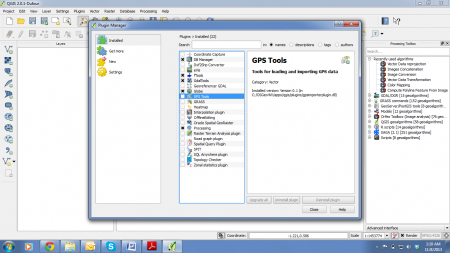Trimble Juno GPS
From AWF-Wiki
| sorry: |
This section is still under construction! This article was last modified on 11/16/2013. If you have comments please use the Discussion page or contribute to the article! |
- This exercise is part of the QGIS Tutorial 2013/14.
In this exercise you'll get an introduction on how to handle a GPS receiver and how to process data in QGIS
During the practical exercise, we work with the GPS receiver Trimble Juno 3B by Trimble navigation. Of course, there are different GPS navigation devices on the market, supplied by several manufacturers, e.g. those listed wikipedia page.
Contents |
Getting started with the GPS receiver
Startup and configuration
- Press the power button for a few seconds
- Open the windows menu and select TerraSync --> Professional Edition. Wait for a few minutes, until you get a connection to at least three satellites.
- Set the coordinate system and other parameters
- To set the coordinate system and other parameters, select Upper --> Setup.
- Set all parameters to the desired configuration and confirm with Done. You are now ready to navigate.
To find a specific spatial point:
- Set the target
- Select Upper --> Data --> Lower --> Existing Data/New
- Select the folder containing the data (e.g. the tree-waypoints used in the exercise) and click Open.
- Select the point you want to navigate to (e.g. Tree01.
- Click Options-->Set Nav Target and set the point you selected before.
- Set the background map
- Select Upper --> Map.
- Click Layers and check the Background and GNSS trail boxes. The background map should now be displayed.
- To zoom in to your location on the map, select Option --> Auto pan to GNSS position or Auto pan to selection for manual zooming.
- Your position and target appear as symbols? on the map.
- Navigation to the target:
- Select Upper --> Map to see the overview of your position and target.
- Select Upper --> Navigation.
- Follow the displayed compass and also check the Distance tab. Note that you need to move to get the compass working.
- To determin the precise position of ground control points (GCPs):
- After having set a target, select New and enter the name of the point (e.g. GCP01). Confirm by clicking Create.
- Select Point generic --> OK.
- Select Option --> Logging interval and set the interval to 1 second.
- Wait for an interval of 100 Blinks and press Done. Confirm with Yes and your point is saved.
Processing in QGIS

Figure A:: The QGIS 2.0 plugin manager
- Open QGIS
- Select Plugin --> Manage and install plugins. Activate the GPS-Tool and eVIS plugins (you can find them by typing the plugin names into the Search bar) as in figure A.
- Click the GPS tools icon
 and select Load GPX File. If you already saved a GPX-file on you computer, browse to the file. If you want to download it from the receiver, connect it to the computer and select Download from GPS.
and select Load GPX File. If you already saved a GPX-file on you computer, browse to the file. If you want to download it from the receiver, connect it to the computer and select Download from GPS.
- Load a raster map from the course data and locate it under the GPS points (see Exercise 01 on how to load layers).